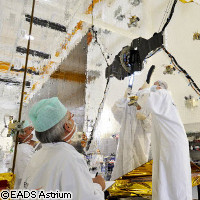Searching for new planets: the EU-funded ROPACS project gets underway
European scientists are searching for Earth-like planets orbiting cooler stars in the EU-funded ROPACS ('Rocky planets around cool stars') project, a Marie Curie training network financed with EUR 3.2 million from the Seventh Framework Programme (FP7). The international team of researchers hopes to discover planets around other stars that might be hospitable to life, and to better understand the origins of life in the universe. A planet's potential habitability depends on whether it is rocky or made of gas, and whether it is close enough to its star for liquid water to be able to flow on the planet's surface. ROPACS, coordinated by Dr David Pinfield of the University of Hertfordshire in the UK, is a network of researchers from the UK, Germany, Spain and the Ukraine who will use the UK Infrared Telescope to identify rocky planets around cooler stars, and determine whether they could support life. The scientists will conduct a 'transit survey' to observe smaller planets passing in front of low-mass, M-dwarf stars. Their large-scale, wide-field camera (WFCAM) Transit Survey (WTS) will take approximately 200 nights' worth of infrared images of the sky, monitoring small changes in the brightness of distant planets as they pass in front of their host star. 'In the past, studies were carried out using optical telescopes, because the Sun and solar-type stars are brightest in the optical range,' explained Dr Pinfield. 'If you want to look for planets that are cooler, you need to look using the infrared instead of the optical, because that's where cooler stars really emit their radiation. As they orbit the cooler stars, they pass in front of the star and it becomes less bright.' The researchers believe that their transit survey might help them find habitable planets near the lowest mass M dwarf stars. Fortunately, their technique allows them to conduct the survey in both fair and poor weather conditions. They will conduct follow-up studies to characterise the mass, radius, density and atmospheres of the transiting planets. 'One of the main ideas behind looking for planets around cool stars is that these planets are smaller than 'sunlight' stars,' said Dr Pinfield. 'One is able to detect smaller planets going around them using the transit method.' Previous transit studies have revealed planets roughly the size of Jupiter; transiting planets around cooler stars could be as much as 10 times smaller. The partners hope that their discoveries will have a positive impact on our understanding of the diversity of habitable planets, and that its high-profile discoveries will provide inspiration for both the general public and students at all stages of their academic careers. One of the project's goals is to develop space-based technology to study extra-solar planets. The training network will support 11 PhD and 4 postdoctoral fellows who will work between institutions (none of the students may work in their home country), and with its commercial partner, space-engineering company EADS Astrium, to detect and characterise new planets and to work on future space technologies. The young researchers will be trained in astronomy, computing, mathematical techniques including specialised algorithms, spectroscopy and engineering design. 'Learning about the diverse range of planetary systems that exist around other stars allows us to better understand our own place in the universe, and will reveal the extent of possible habitats for life elsewhere,' said Dr Pinfield. The project's kick-off meeting is planned for 28-29 January. The inspiration behind the project is, simply, discovery. 'For me, discovering new things that weren't there before has always been very exciting,' Dr Pinfield commented. 'So the idea of finding these smaller planets and moving closer to the goal of finding terrestrial planets that could be host to other life in the universe - that is very exciting indeed.'
Countries
Germany, Spain, Ukraine, United Kingdom



